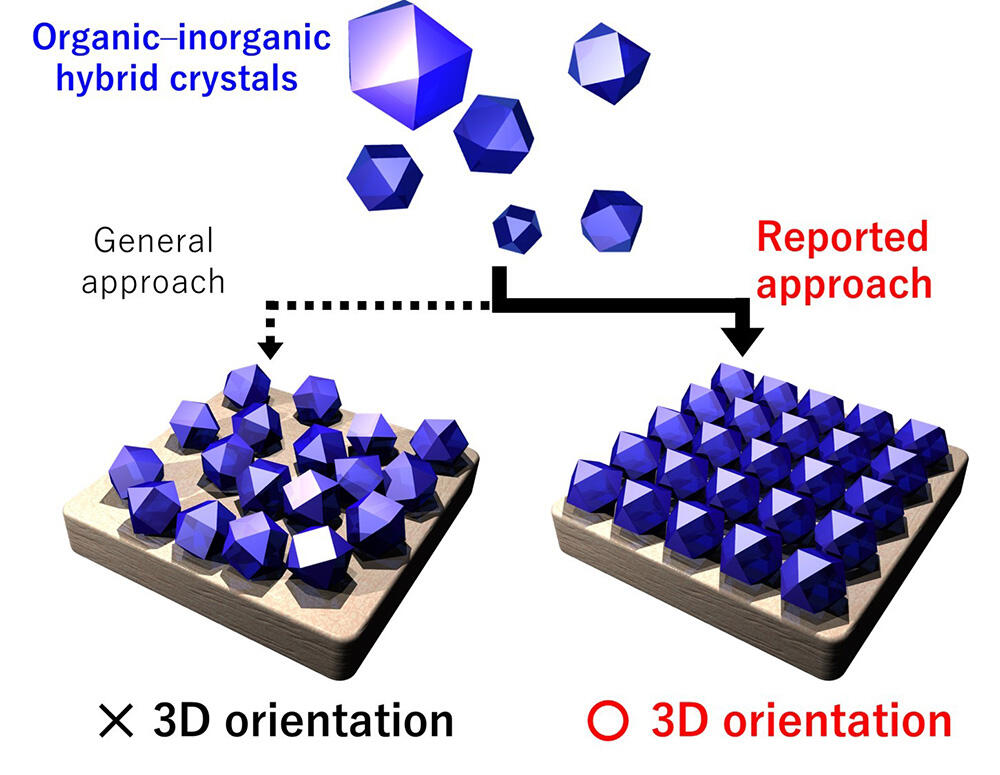A research group led by Associate Professor Kenji Okada, Assistant Professor Arisa Fukatsu, and Professor Masahide Takahashi of Osaka Prefecture University Graduate School of Engineering has developed a technique for orienting metal-organic framework crystals, which are isotropic organic-inorganic hybrid crystals, on a substrate through a simple reaction in a beaker. Until now, it has been difficult to align the orientation of isotropic crystal particles. Therefore, the research group developed a thin film in which crystals are three-dimensionally oriented by manipulation of functional groups within the crystal structures. The group has also developed a method for designing and controlling the path (conductive path) through which electrons flow in the resulting metal-organic framework crystal, resulting in a thin film that exhibits high conductivity in a specific direction. The material developed by this research is expected to play a significant role in the development of molecular and integrated devices. This was selected as a "Hot Paper" by Journal of Materials Chemistry A.
Sand and quartz are both composed of silicon dioxide, but they look completely different depending on whether they are composed of a single or multiple crystals. Silicon, which is used in semiconductors, functions in its single crystal formation. In industrial settings, the production of single crystals requires high temperature, high pressure, and precise atmosphere control. If polycrystals could be designed to exhibit functions similar to those of single crystals, the manufacturing process would be greatly simplified, and the use of crystals for applications that are currently inhibited by difficult manufacturing processes would expand significantly. In order for a polycrystal to function like a single crystal, the individual crystal grains must be aligned and the gaps between them must be eliminated. Anisotropic crystals, which are shaped like tissue boxes, can be forcibly oriented using electric or magnetic fields. However, it has been considered extremely difficult to align isotropic crystal particles that are cube- or sphere-like in shape. As organic-inorganic hybrid materials, which are composed of both organic and inorganic components, possess unique collections of characteristics, including the high functionality and flexibility of organic molecules and the reliability of inorganic substances, they are used to synergistically improve material functions in a variety of fields, including medicine, information processing, and environmental science. However, the properties of such materials are strongly dependent on the orientation of the organic-inorganic hybrid crystals on their substrate.
The research group has previously studied the regularity of the surface hydroxyl groups of metal hydroxides and has developed a thin film in which the metal-organic framework is oriented over a large area by epitaxially growing the metal-organic framework. In this study, the group has further pushed this technology and has, for the first time, developed a process for orienting metal-organic framework crystals regardless of particle shape, by utilizing minute differences in the orientation of molecules within the crystals. The metal-organic framework has molecular-sized pores, and specific molecules can be introduced into specific pores by defining the orientation and spacing. In this research, the group has also developed a method for designing and controlling the path (conductive path) through which electrons flow, due to the interaction between the crystal skeleton and organic semiconductor molecules in the metal-organic framework crystal, and this has allowed the researchers to produce thin films with high conductivity in a specific direction.

Credit: Osaka Prefecture University
In thin films produced using previous methods, the electrical characteristics of the films could not be freely controlled because the crystals of the metal-organic framework were not oriented. However, the thin film produced using the group's new technology allows electricity to be guided in a specified direction. In fact, the film exhibited about 10 times more conductivity in the specified direction than in other directions. Conductive metal-organic frameworks have been studied extensively around the world and are considered one of the promising materials for next-generation integrated devices. However, this group is the first to produce a thin metal-organic framework that can freely control electrical characteristics over a large area. Furthermore, since thin films produced using this technology have oriented microcrystals, they exhibit much greater flexibility against deformation than single-crystal thin films do. These new films are expected to be used in the development flexible semiconductor devices.
This approach of orientating and growing an organic-inorganic hybrid crystal using the minute differences between the crystal structures and the orientation of the molecules in the crystal can be applied both to metal-organic frameworks, such as those successfully used in this research, and to a variety of other crystalline organic-inorganic hybrid materials.
This article has been translated by JST with permission from The Science News Ltd.(https://sci-news.co.jp/). Unauthorized reproduction of the article and photographs is prohibited.




